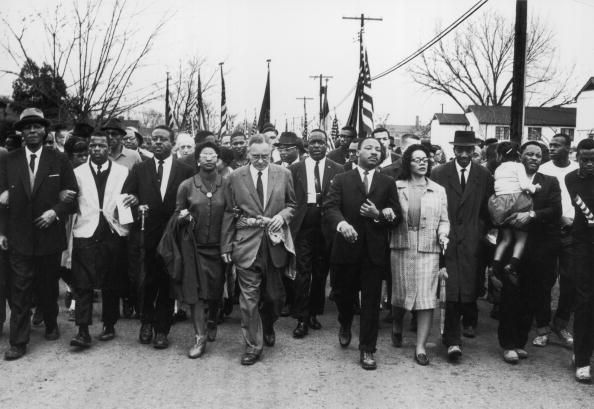‘Bloody Sunday’: Selma March Anniversary Held Without John Lewis, Other Civil Rights Legends For First Time

Martin Luther King and his wife Coretta Scott King lead a black voting rights march from Selma, Alabama, to the state capital in Montgomery; among those pictured are, front row, politician and civil rights activist John Lewis (1940 – 2020), Reverend Ralph Abernathy (1926 – 1990), Ruth Harris Bunche (1906 – 1988), Nobel Prize-winning political scientist and diplomat Ralph Bunche (1904 – 1971), activist Hosea Williams (1926 – 2000). | Source: William Lovelace / Getty
UPDATED: 8:15 a.m. ET, March 7, 2021
The historic “Selma to Montgomery marches,” with the first of the three protest marches known as “Bloody Sunday,” took place 56 years ago today and highlighted a turbulent time of the Civil Rights Movement of the 1960s. The Student Nonviolent Coordinating Committee (SNCC) led voter registration drives in the small town of Selma, Alabama, with the intent of combating white resistance toward African Americans gaining rights to vote in elections.
This year’s anniversary marks the first time in the march’s history that it will take place without several of its founding organizers. That includes the legendary John Lewis, the Rev. Joseph Lowery, the Rev. C.T. Vivian and attorney Bruce Boynton. All four of those civil rights icons died last year.
SEE ALSO: Prince Hall, Group Of African Americans Admitted To Freemasonry On This Day In 1775
They, along with Dr. Martin Luther King Jr. and the Southern Christian Leadership Conference (SCLC), the gathering of activists held several demonstrations to protest the death of fellow protester Jimmie Lee Jackson (pictured below) who was shot and killed by Alabama State Trooper James Bonard Fowler.

Source: Justin Sullivan / Getty
On March 7th, more than 600 hundred marchers led by the SNCC and SCLC gathered in Selma to march in solidarity. Coupled with the original aim of the protest, marchers also wanted to call attention to the denial of their voting rights. With the 1964 Civil Rights Act passing, King and other leaders hoped the gathering would speed along the opportunity for fairness.
Led by the late Georgia congressman John Lewis (then-chairman of the SNCC) and Rev. Hosea Williams of the SCLC, the marchers were undeterred until they reached the Edmund Pettus Bridge that crosses the Alabama River heading into Montgomery.

State troopers watch as marchers cross the Edmund Pettus Bridge over the Alabama River in Selma, Alabama, as part of a civil rights march on March 9, 1965. Two days before troopers used excessive force driving marchers back across the bridge, killing one protester. | Source: Bettmann / Getty
Police gathered and formed a wall barring the passing of the marchers after Sheriff Jim Clark called all able-bodied white men to become temporary deputies and assist in enforcement.
When Rev. Williams tried to peacefully reason with the officers, shoving matches ensued and the carnage began, officers fired tear gas into the crowd and began beating the nonviolent protesters with billy clubs.
The aggressive actions of the Alabama police force were televised nationally and around the world, sparking fierce debate and renewed support for the Civil Rights Movement. Reports vary, but between 17 and 50 people were injured and hospitalized with one woman, Amelia Boynton, nearly beaten to death.
Watch real-time news coverage of Bloody Sunday here:
Defiantly, Dr. King roused nationwide support for the following march known as “Turnaround Tuesday” and returned to Selma on March 9th.
Although the SCLC tried to legally obtain a court order to march to Montgomery, they were denied the document. The march went on, but in order to stay within legal means, King did not violate the court order and instead instructed the 2,500 walkers to turn around after a short prayer.

Two young African American boys stand in the street with other onlookers watch the Selma to Montgomery civil rights marchers go by on March 25, 1965, in Montgomery, Alabama. | Source: Stephen F. Somerstein / Getty
It was known that the SNCC wanted more radical action compared to the peaceful tactics of the SCLC, but King was able to manage the tensions between the groups. On March 21 and under federal protection, a massive group of 8,000 marched successfully to Montgomery and were met with a “Stars For Freedom” rally, featuring Sammy Davis, Jr., Harry Belafonte, Tony Bennett, Nina Simone and more.
Sadly, Ku Klux Klan members angered by the protests killed two White persons who supported the marchers and their movement.
It would be several months until the Voting Rights Act Of 1965 would pass in August of that year, solidifying that the SNCC’s and SCLC’s hard work was not in vain.

President Barack Obama walks alongside Amelia Boynton Robinson (R), one of the original marchers, the Reverend Al Sharpton (2nd R), First Lady Michelle Obama (L), and Rep. John Lewis (2nd-L), Democrat of Georgia, and also one of the original marchers, across the Edmund Pettus Bridge to mark the 50th Anniversary of the Selma to Montgomery civil rights marches in Selma, Alabama, March 7, 2015. | Source: SAUL LOEB / Getty
With Black people in Alabama finally able to cast ballots without being blocked by racist authority figures, Sherriff Clark was voted out immediately.
The Selma marches show that through concerted effort and some measurable pain, African Americans were able to withstand the brunt of racism and achieve heights long denied to them simply because of racism.
Today, many of us reap the benefits of the Selma marchers’ determination to create a fair and balanced life for all.
SEE ALSO:
RIP To An Icon: Let’s Recall Rev. Joseph E. Lowery’s Brilliant Benediction At Obama’s Inauguration
Civil Rights Warrior Amelia Boynton Robinson, Portrayed In ‘Selma,’ Dies At 104
John Lewis, Civil Rights Icon Who Became Powerful Congressman, Dies At 80
C.T. Vivian, Civil Rights Pioneer And Reverend Who Worked With Martin Luther King, Dies At 95
[ione_media_gallery id=”3096025″ overlay=”true”]

